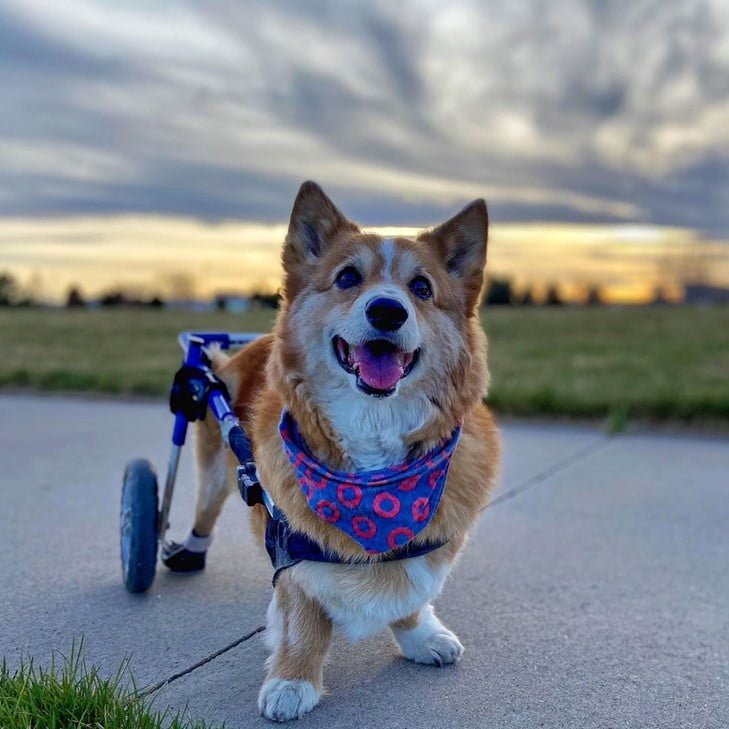Beagle Lifespan: How Long Do Beagles Live? (Life Expectancy)

What You Need to Know About Caring for a Dog with a Bad Back
Having a bad back can be a real pain, especially when you’re a dog. Dogs can experience back pain and back problems just like humans, ranging from minor back pain to a debilitating spinal condition impacting a dog’s ability to walk. Slipped discs, strains, intervertebral disc disease, and arthritis are just a few of the back conditions affecting dogs. Here are a few helpful tips for caring for a dog with a bad back:
Know the Genetic Risks and Hereditary Spinal Conditions in Dogs
Certain dog breeds are more prone to back problems, so understanding the spinal conditions that your dog is predisposed to can help you provide the proper care for your dog as they grow.
Dachshund and Corgis: IVDD

Most often impacting mobility in long-bodied dogs such as dachshunds or corgis, Intervertebral disc disease in dogs can also be diagnosed as a herniated or slipped disc. IVDD affects a dog’s mobility when the spinal disc rupture presses along the spinal cord and disrupts communication between the spinal cord and the brain. This breakdown in communication impacts a dog’s leg function and mobility.
The severity of a dog’s mobility loss depends on the location of the spinal damage and how bad the disc rupture was. Although the symptoms of intervertebral disc disease typically appear suddenly, in some cases, the onset of IVDD occurs gradually.
German Shepherd: Degenerative Myelopathy
DM is an inherited disease that impacts the German Shepherd more than any other breed. Degenerative myelopathy is a degenerative spinal condition characterized by hind leg weakness that progresses to eventual paralysis.
Doberman Pinscher: Wobbler Syndrome or Cervical Spondylomyelopathy
50% of all wobbler syndrome cases occur in the Doberman Pinscher breed and are typically diagnosed before the age of three. Due to compression of the spinal cord and the nerves in the neck, dogs with wobblers experience mobility problems, uncoordinated walking, and neck pain.
Pug, English Bulldog, and French Bulldog: Hemivertebrae
Hemivertebrae is a congenital condition where the spine develops incorrectly, causing curvature in the spine. The spinal condition hemivertebrae most commonly affects screw tail dogs such as Boston terriers, bulldogs, French Bulldogs, and pugs. Common spinal deformities from hemivertebrae include:
- Lordosis - a swayback curvature of the lower spine
- Kyphosis - spinal curvature that is up and down
- Scoliosis - a spinal curve that is side to side
Preventative Care and Keeping Your Dog’s Back Healthy
Pets with a history of back problems or looking to avoid a back injury can make a few simple changes to promote a healthy back.
Watch your pet’s weight
Keeping your pet at a healthy weight can significantly impact their back health. An overweight dog places additional stress on their spine and back. By helping your dog lose unwanted weight, they lower the risk of exasperating their back problem.
Exercise
Along with a healthy diet, monitoring their exercise and keeping them active promotes a healthy lifestyle. Dogs or cats prone to back problems should work with a certified rehab specialist to increase the strength of their back and build up the muscles that support the spine.
Avoid jumping
Limit your dog’s jumping. Dogs with spinal conditions and bad backs should avoid jumping on or off furniture at all costs. One bad jump can cause a disc to rupture or put unwanted stress on your dog’s spine, causing a back injury. Instead, utilize dog ramps and pet stairs, and gently lift your pet on and off furniture to lower the risk of injury.
Understand the Symptoms of Back Problems in Dogs
Dogs cannot tell us how they’re feeling, so it's essential to know the signs of canine back pain in case of problems.
- An arched back or changes in posture can indicate back pain
- Reluctance to walk or standing up very slowly after resting
- Leg weakness, specifically in the back legs
- Wobbly gait when walking
- Crying out when touched or increase vocalization while dog is moving
- Difficulty turning or raising their head
Know the Right Way to Pick Up Your Dog
To avoid any more injury, please make sure you know the right way to pick up your dog. Always support both the front and back of your dog at the same time. Dogs with a bad back need to simultaneously be supported from underneath the chest and rear end. Always keep your dog’s spine fully supported and level. While holding your dog, be sure to hug them close to your chest to provide even support across the body and place your other arm under your dog’s entire body. When you’re ready to put them down, gently lower your dog to the ground. Your dog should be safely touching the floor before your release them. A sudden drop, even a small one, can hurt the spine.
Avoid lifting a dog up from under their armpits or pulling them out of their crate without supporting them as this strains their back and puts your dog at risk for spinal injury in the future. The dachshund breed is at a high risk for slipped discs and intervertebral disc disease. Dachshunds and other breeds prone to disc conditions and back problems should always have their back supported when carried. Knowing the right way to pick up your dog can help prevent future back problems.
Dog Wheelchairs for Dogs with Back Issues
Back issues and paralysis can be closely connected. The Walkin' Wheels dog wheelchair is the ideal solution for paralyzed dogs to help keep them active. A dog wheelchair supports under your dog's hips allowing them to stand and walk with the cart's assistance. A wheelchair can be incorporated into your dog's rehab exercises or be used to help your dog get outside to go to the bathroom.
Related Articles:










